COVID-19 prompted sudden and significant changes in how we live, work, and educate our kids. America’s wireless networks rose to the occasion, handling the unprecedented surges in mobile voice and data traffic driven by COVID-19.
The data back this up: America’s mobile speeds kept pace and consumers expressed widespread approval of their wireless experience as well as industry’s COVID-19 response. Our wireless networks fared exceptionally well even as providers worked to keep consumers connected, offered more wireless data as demand surged, and provided support to millions of subscribers impacted by COVID-19’s economic challenges.
This is even more remarkable in comparison to other countries, where wireless networks strained to maintain quality and speed.
America’s wireless success is no accident or stroke of luck. Our networks met the challenges presented by COVID-19 thanks to the billions of dollars the industry invests annually to build some of the world’s most resilient networks, to the world’s best engineers and network technicians, and to the policymakers who moved quickly to help providers add capacity.
It is also thanks to a long-standing national regulatory framework that promotes competition and investment. This approach helps spur U.S. wireless companies to build for future growth, and to ensure Americans have the best wireless experience—and value—in the world.
COVID-19 presented the ultimate stress test for wireless networks, and our country’s wireless networks kept Americans connected when they needed it the most. It also underscored that those without connectivity have faced greater challenges and inequities in opportunities during COVID-19. We must all work together collaboratively to bridge the digital divide, and we are committed to expanding opportunities for all Americans.

“Americans are relying on wireless more than ever before. Every day, the wireless industry is out there improving our country’s mobile networks, investing tens of billions of dollars each year, so people can be connected when they need it most.”
— Meredith Attwell Baker, President & CEO

Read Meredith’s blog on how the wireless industry keeps us connecting during COVID-19.
America’s wireless success is no accident or stroke of luck. Our networks met the challenges presented by COVID-19 thanks to the billions of dollars the industry invests annually to build some of the world’s most resilient networks, to the world’s best engineers and network technicians, and to the policymakers who moved quickly to help providers add capacity.
Meredith Attwell Baker, CTIA President & CEO
In a week in mid-March, much of the U.S.—hundreds of millions of people—quickly transitioned from their normal lives to staying at home as much as possible. This monumental shift, occurring in just a few days, meant a widespread and rapid transformation in how Americans used their wireless devices and networks.
-
** Voice traffic and texting rose significantly ** . Voice traffic increased from 20-40% on wireless networks. This growth is all the more significant since nearly 80% of voice connections in the U.S. are wireless. Major wireless providers also saw a 25% increase in texting.
-
** Mobile data use jumped .** COVID-19 drove significant increases in wireless broadband demand, with mobile data traffic up nearly 20%. For some wireless providers, that’s like adding almost eight months of data increases practically overnight, yet U.S. wireless networks handled this abrupt spike in traffic with rapid reconfiguration of capacity.It’s important to note that this COVID-19-traffic increase is on top of the regular rising mobile data traffic trends, which are significant in their own right. For instance, the increase in mobile data traffic in 2019 from 2018 alone was greater than the entirety of mobile data traffic just four years ago.
-
** Traffic patterns changed overnight. ** Wireless providers build networks on well-established traffic patterns; for instance, mobile data use flows into commercial districts in cities during business hours. With so many people staying home, data traffic patterns often shifted—quite rapidly—from dense business areas to other areas such as residential locations, without degrading the network.One wireless provider saw an 86% jump in subscribers connecting to cell sites only in their primary location—like someone’s home—and another provider saw a nearly 30% decline in mobile handoffs, which occur when consumers’ data connections shift cell sites.
-
** Mobile hotspot use soared. ** One nationwide provider found customers were using their mobile device’s hotspot nearly 40% more than average to share that mobile data connection with other devices.
- ** Application use rocketed. ** The Cleveland Clinic saw monthly telehealth visits jump from 3,400 to over 60,000—an increase of more than 1,700%. Traffic volume for Cisco’s Webex web/video conferencing service spiked 24x above normal. One nationwide provider saw a 1,200% increase in online collaboration tools, and educational app traffic jumped nearly 150%.
Yet U.S. wireless networks did what they were designed to do: handle these dramatic shifts and increases in use with relative ease.
Americans were able to connect to their family, friends, and co-workers even in the face of this unprecedented, extended, nationwide change in network demands.
- ** U.S. mobile data speeds kept pace. ** In fact, mobile download speeds in the U.S. actually went up slightly in April and some researchers found that America’s wireless networks actually had a “statistically-significant increase in download speeds.”

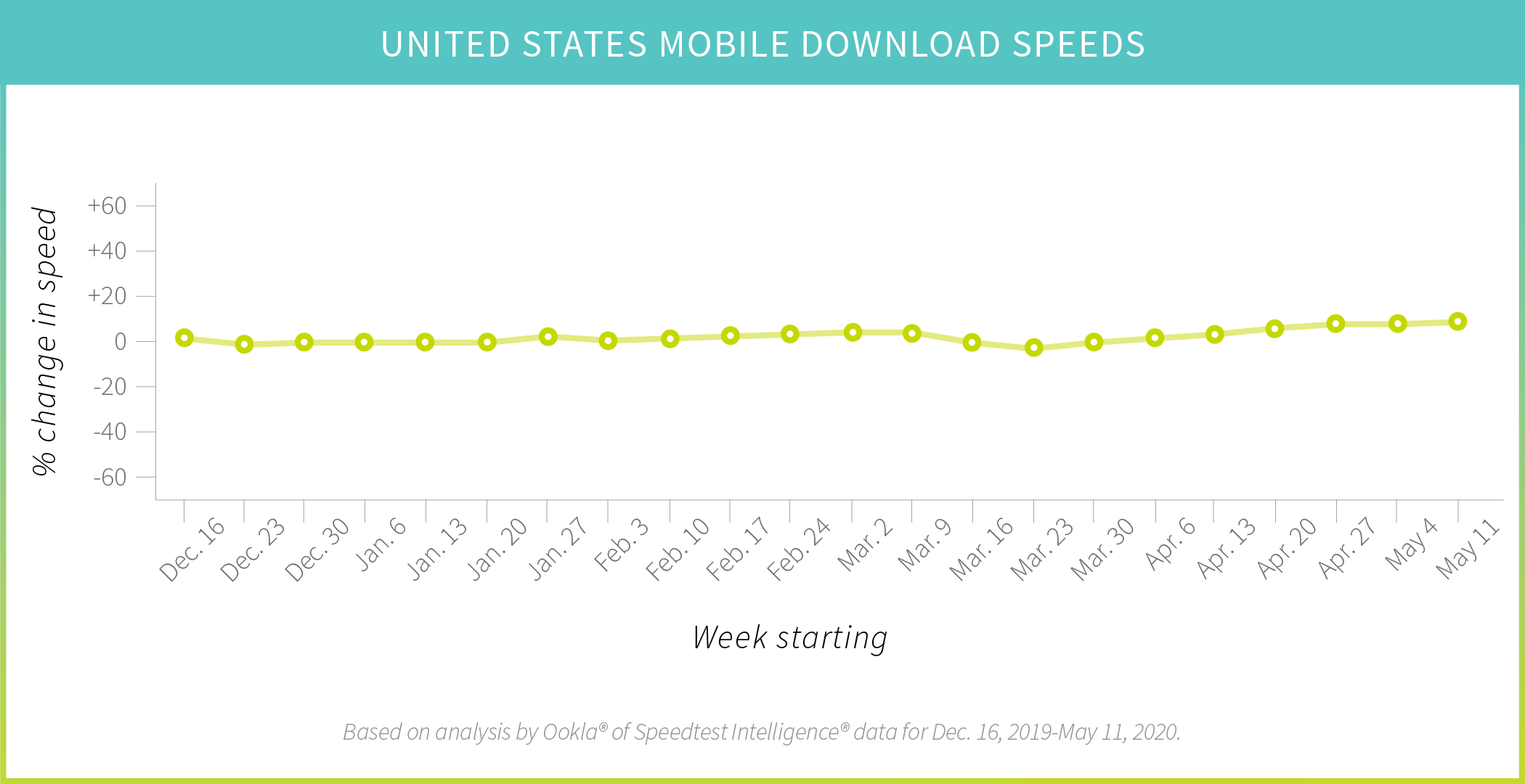
- ** Consumers satisfied with wireless. ** 83% of Americans said their wireless/mobile internet service met their needs.
- ** Wireless considered a leader in responding to COVID-19. ** Americans viewed the U.S. wireless industry as a leading industry handling COVID-19, alongside hospitals and the technology industry.
The strong performance by U.S. wireless networks is particularly important for the nearly 20% of Americans who own a smartphone but don’t have fixed broadband connections at home. That’s a lot of people relying on our networks without easy access to additional options like Wi-Fi at home to keep them connected—people who are more likely to be black, Hispanic, or low-income, and wireless providers work hard to meet their connectivity needs.
The U.S. wireless industry is also intensely competitive, and that dynamic helped drive providers’ pro-consumers initiatives during COVID-19. From waiving overage charges and adding data to many wireless plans to providing service to kids who don’t have internet access and offering free service to front-line health workers, national and regional wireless operators stepped up in extraordinary ways.
A key prerequisite for these initiatives was confidence in wireless networks’ ability to meet the increased COVID-19 traffic demand.
Investing, Building, and Optimizing the Best Wireless Networks.
Keeping people connected is the wireless industry’s number one job. Wireless providers are committed to keeping people connected, especially when they need it most, by investing, building, and managing their wireless networks.
Investing in Strong and Resilient Wireless Networks
The U.S. wireless industry has for years invested hundreds of billions to strengthen wireless networks. The reason is simple: to meet consumer demand, wireless providers have to improve their networks, week-in and week-out. Mobile data traffic has risen by 284% since 2015.
To successfully meet that kind of explosive growth with reasonable headroom, wireless providers are always looking for more spectrum—or repurposing existing spectrum—building new facilities, enhancing existing ones, and making their networks more efficient with the latest technologies. As one example, U.S. wireless providers have increased their spectrum efficiency 42 times since 2010, handling significantly more data traffic per megahertz of spectrum.
In fact, wireless networks are designed to accommodate peak usage scenarios higher than even the highest COVID-19-related network traffic surge.
In many ways, wireless providers were ready for COVID-19 because we are already building for America’s wireless needs in 2021 and beyond. This non-stop investment cycle differentiates our industry.
In the past few years, wireless providers have also invested billions to prepare for 5G, the next-generation of wireless. This 5G-focused investment has helped prepare wireless networks to meet Americans’ mobile connectivity demands during COVID-19. And 5G connectivity itself will boost network capacity and be much more efficient in how it uses spectrum.
Many providers have increased capital spending to meet COVID-19-driven network demands; Verizon, for instance, upped its 2020 capex by half a billion dollars.
These significant investments meant that wireless calls were able to go through, kids’ remote learning sessions could connect, and telehealth video conferences went smoothly.
Network Management Ability and Expertise
With wireless use patterns shifting throughout the day and night due to a COVID-19-driven drop off in commuting times and a surge in telework and video conferencing, the importance of network traffic management became even more important.
Wireless network engineers have proven more than up to the task, monitoring traffic 24/7 and shifting network resources to optimize the network and ensure consumers get the connectivity they need to live, work, and learn.
Wireless engineers and technicians continue to work tirelessly—and as safely as possible by taking important safety precautions and following CDC guidelines—to further optimize and add network capacity. That means continuing to deploy new wireless infrastructure including cell sites and additional spectrum assets quickly and efficiently. In some areas where additional capacity is needed, wireless providers have even deployed portable cell sites, known as COWs, that are normally used to keep people connected during natural disasters.

Operators waived fees, increased data, and kept hotspots open for underserved Americans.

To keep kids learning, wireless companies provided free service and resources to kids without access.

Wireless providers offered free service to front-line health workers, keeping them connected as they kept us safe.

The industry contributed tens of millions of dollars to a variety of organizations helping relief efforts.
Help from Policymakers and Stakeholders
Thanks to flexible policies, quick action, and strong FCC leadership, wireless providers quickly tapped additional spectrum resources—up to 100 megahertz, a nearly 14% increase in low-band spectrum availability—to boost capacity in key regions of the country. These spectrum assets, on loan from other providers or the FCC, were instrumental in providing additional capacity in key areas of the network where demand was surging.
By moving in days or even hours, the FCC enabled wireless providers to boost wireless capacity—resulting, in some cases, in a doubling of capacity and speeds in some areas. Responding to CTIA’s request, the FCC has implemented electronic filing procedures to streamline that process further going forward.
The wireless industry also needs to continue deploying network infrastructure, including in areas where we see new demand driven by COVID-19. We also recognize the challenges and constraints that states and municipalities and their employees now face.
Many municipalities recognized the importance of continuing to process wireless infrastructure applications during COVID-19 and updating their processes and rules to reflect the changes necessary to do so safely and efficiently. These efforts are commendable and should continue. CTIA also developed best practices for state and local government COVID-19-related permitting issues for consideration.
CASE STUDY: Consumers Benefit From Rapid Deployment of Additional Spectrum

CASE STUDY: Consumers Benefit From Rapid Deployment of Additional Spectrum
U.S. Cellular customers in parts of Wisconsin, Iowa, Illinois, New Hampshire, Maine, and North Carolina received a major capacity boost thanks to a partnership with Ericsson and quick FCC action allowing the wireless provider to borrow spectrum from other wireless companies to help meet COVID-19-related increases in network demand.
“We’ve seen an increase in voice, SMS and data traffic in recent weeks, but we’ve designed a highly reliable, hardened network that can withstand shifts in bandwidth needs and handle unexpected increases in usage,” said Michael S. Irizarry, CTO/EVP for U.S. Cellular.
Covid-19-Related Mobile Network Speed Declines in Other Countries.
Mobile networks in other countries didn’t fare as well as those in the U.S.
China’s mobile download speeds saw decreases of up to 40% during the peak of their COVID-19 restrictions, while Italy saw decreases of up to 23% and Spain saw decreases of up to ~15%, according to Ookla.
Over two-thirds of European countries experienced mobile speed decreases of up to 30% in late March, according to OpenSignal.




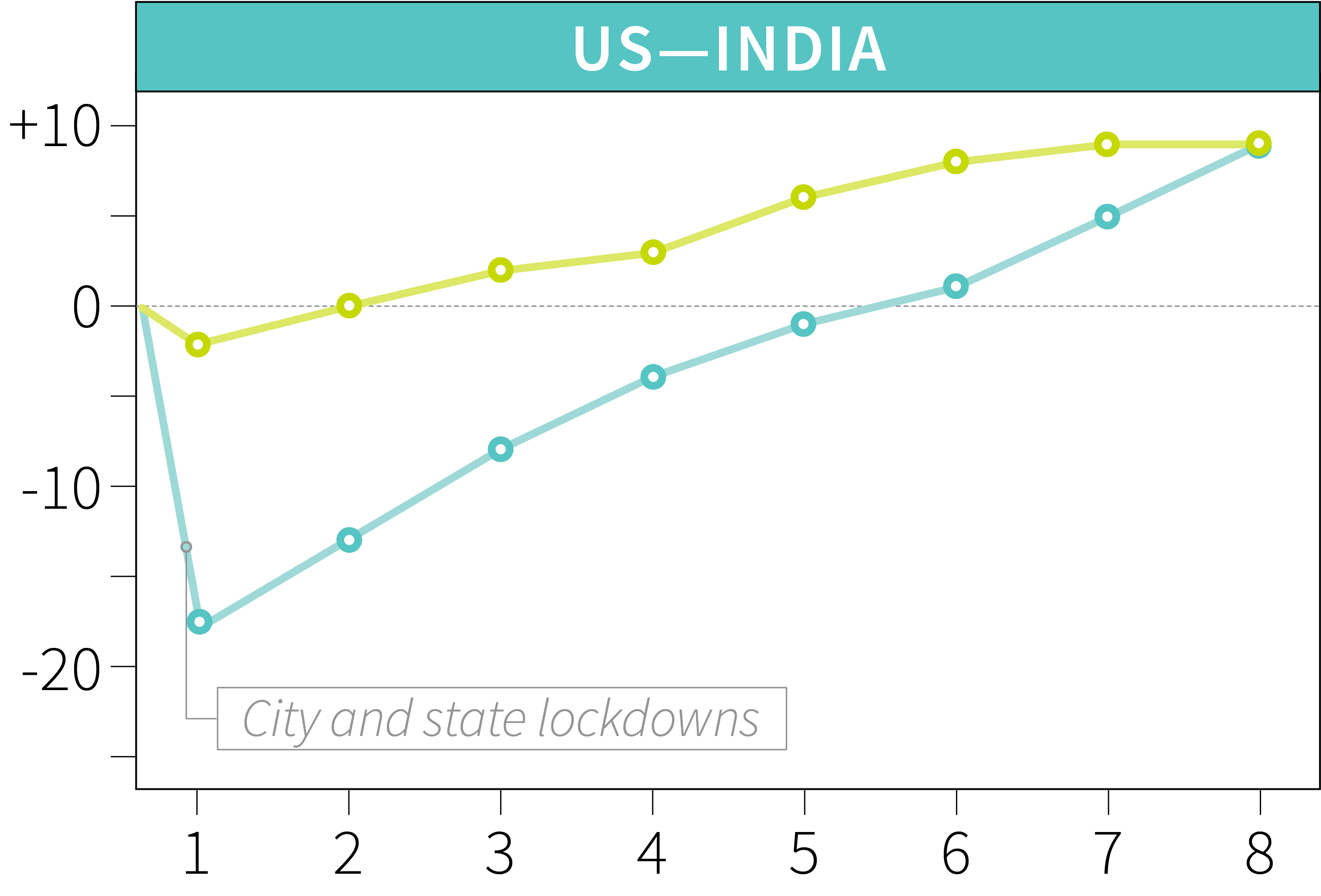

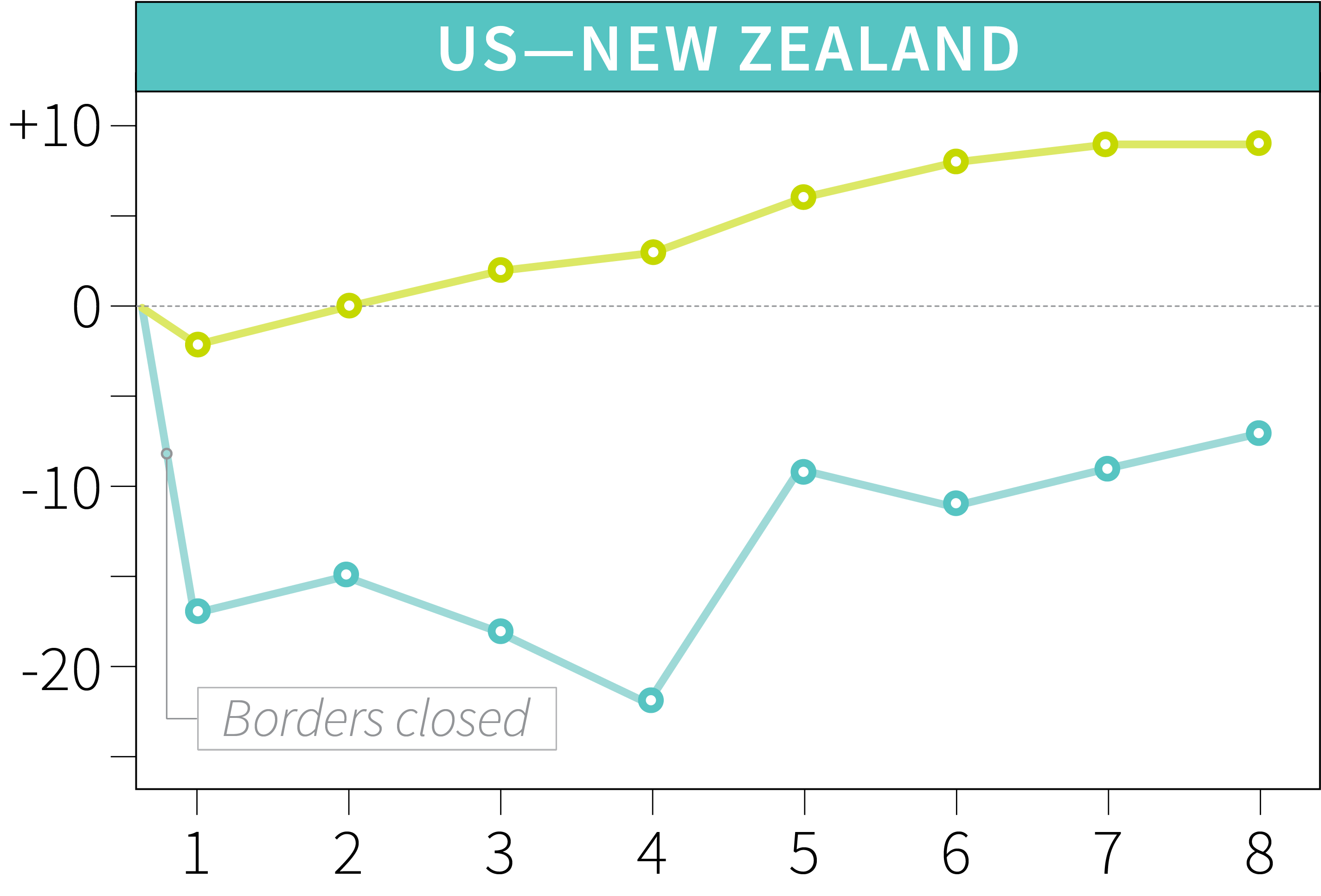





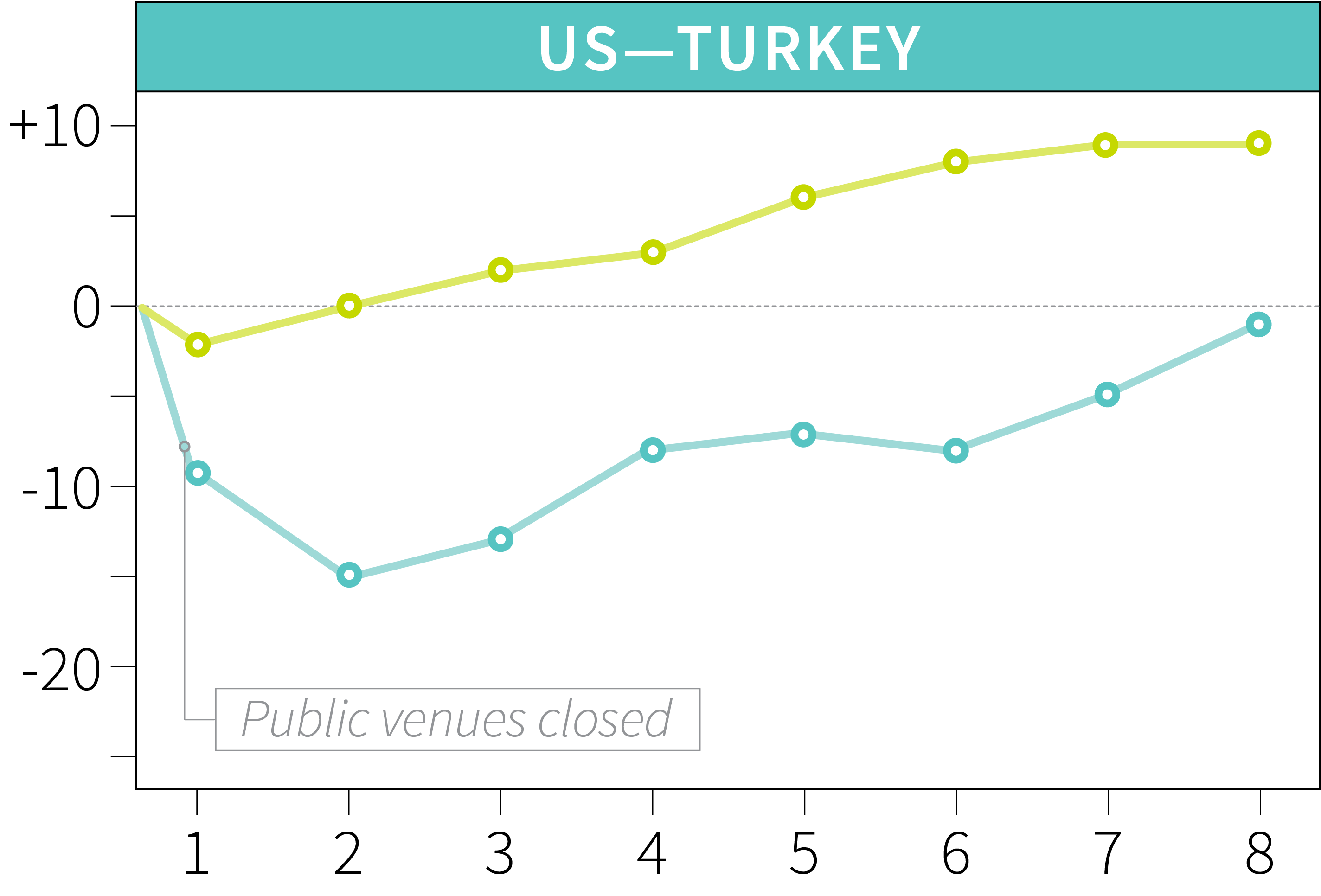
U.S. Wireless Compared To Europe: More Investment, More Availability/Use, and More Value.
America’s wireless networks held up well compared to countries around the world during COVID-19. U.S. providers or policymakers haven’t had to ask consumers or edge providers like streaming video companies to reduce content quality/bandwidth use like the European Union did. U.S. wireless speeds stayed strong or even slightly increased, while many other countries saw noticeable dips in network performance.
These positive outcomes stem from a forward-thinking regulatory framework that promotes investment and competition. This investment and market dynamism pays real dividends in terms of consumers’ wireless experience.
A brief comparison to Europe—which has a population over double the U.S.—provides evidence as to why our country was able to avoid these complications:
- * U.S. wireless investment significantly greater than Europe. * European mobile operators invested ~$17.7B in 2018, while the U.S. wireless industry invested $27.4B—nearly $10 billion more. Looking back at the past five years, U.S. operators have invested over $50 billion more than European operators.

EU Commissioner Thierry Breton … tweeted that he’d spoken with Netflix CEO Reed Hastings and asked Netflix to stop showing video in high definition in order to ‘secure Internet access for all.
That investment flows down in a significant way to each wireless subscriber: U.S. wireless providers invested over 70% more—$82.28 per person vs. $47.94 per person—in 2018 on a per capita basis, compared to European operators.
- ** High-speed 4G availability remarkably strong in the U.S. ** Americans have the highest 4G availability for a country the size of the U.S. according to Open Signal, and we even beat out geographically smaller countries like Sweden, France, and Italy.
- ** North American wireless data use significantly greater than Europe. ** The average mobile data use in North America was 10 GBs/month compared to 5.8 GBs/month in European countries—nearly 73% more.
These investments have paid off, in terms of both avoiding declines in network performance, speed and quality as well as the superior performance and value that Americans receive from wireless networks.
Earlier this year, a comprehensive study looked at 1,554 wireless plans from 213 wireless providers across 36 countries. The study concluded the U.S. ranked first in value proposition.
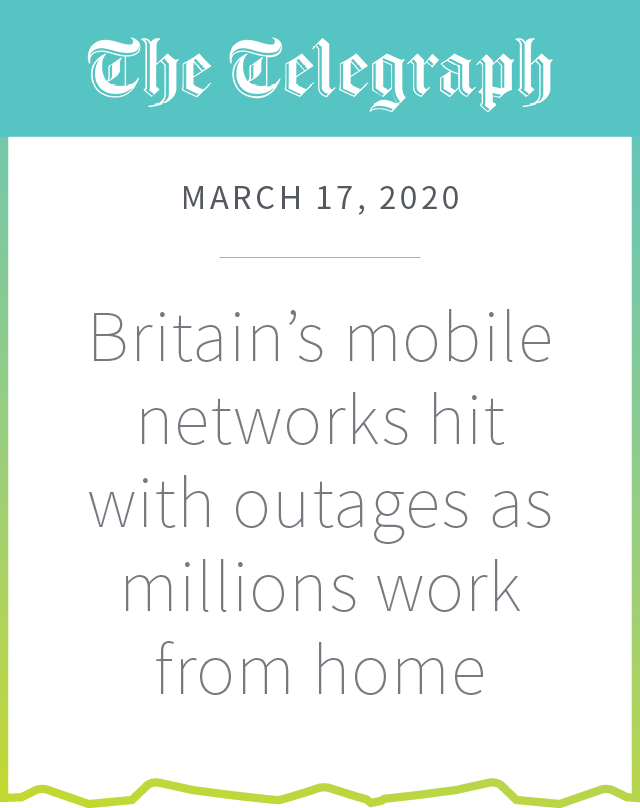
In the wake of a crisis that put a spotlight on the need for innovation in healthcare and education, 5G will help boost our economic recovery, create jobs and enable exciting new telehealth and remote learning opportunities.
Meredith Attwell Baker, CTIA President & CEO
What’s Next: How 5G Can Help Drive the U.S. Recovery and Rebuild Our Economy.
While most Americans have been staying at home, America’s wireless providers have continued deploying the spectrum and infrastructure that will power the next-generation of wireless networks. 5G will boost our economy, create jobs, and bring people new wireless-powered services—like telehealth and remote learning—at a time where we’re seeing firsthand the benefits of this type of connectivity and the opportunities it enables.
To continue the incredible resiliency and reliability of our wireless networks, ensure our leadership of the emerging 5G economy and help spur economic growth and job creation post COVID-19, it’s crucial that policymakers make progress on spectrum and infrastructure issues, as well as the digital divide.
Today, 60% of Americans are covered by initial 5G deployments and by the end of year, this next-generation of wireless will be available across the U.S. We’re in this strong position thanks to smart government policies that incentivize investment, promote competition, prioritize the additional licensed spectrum, and speed the buildout of new wireless infrastructure.
This regulatory framework has been embraced by policymakers on both sides of the aisle. If we continue this winning formula, we will help ensure our leadership of the emerging 5G economy and help spur the economic growth and job creation post COVID-19 that America needs.

Spectrum. The FCC should continue to move forward on two planned mid-band spectrum auctions—3.5 GHz and the C-Band—this year and policymakers should focus on the lower 3 GHz band as the next near-term spectrum priority. Policymakers and industry also need to come together to identify the next set of spectrum bands that will help meet our future needs with a focus on key mid-band spectrum held by the federal government.
Infrastructure. Building more towers and small cells and upgrading existing facilities will help add new capacity for Americans today and help meet future mobile demand. An investment-friendly framework that promotes streamlined deployment is key to continued investment in the wireless infrastructure that powers our economy.
One issue that will help put Americans back to work—literally building the foundation for wireless connectivity—is permitting. Congress can support America’s wireless demands and our country’s economic recovery by: encouraging deployments in existing wireless structures, and provide funding for zoning and permitting offices to safely and efficiently approve new wireless infrastructure deployments. Earlier this month, the FCC adopted a “5G Upgrade Order” that will help foster wireless network buildout, allowing providers to rapidly upgrade existing facilities with next-generation infrastructure.
Digital Divide Commitment. Millions of Americans with broadband connections have been able to navigate these difficult times by keeping connected. We’re proud of industry efforts to help connect more Americans, but we have much more work to do together. Those without broadband have faced more challenges, and Congress, policymakers and industry can and should do more. That means providing dedicated funding for education hotspots, providing the resources to expand broadband in rural areas, and ensuring Americans have equitable access to online opportunities.
Email Newsletters
Sign up to receive TelecomTV's top news and videos, plus exclusive subscriber-only content direct to your inbox.



